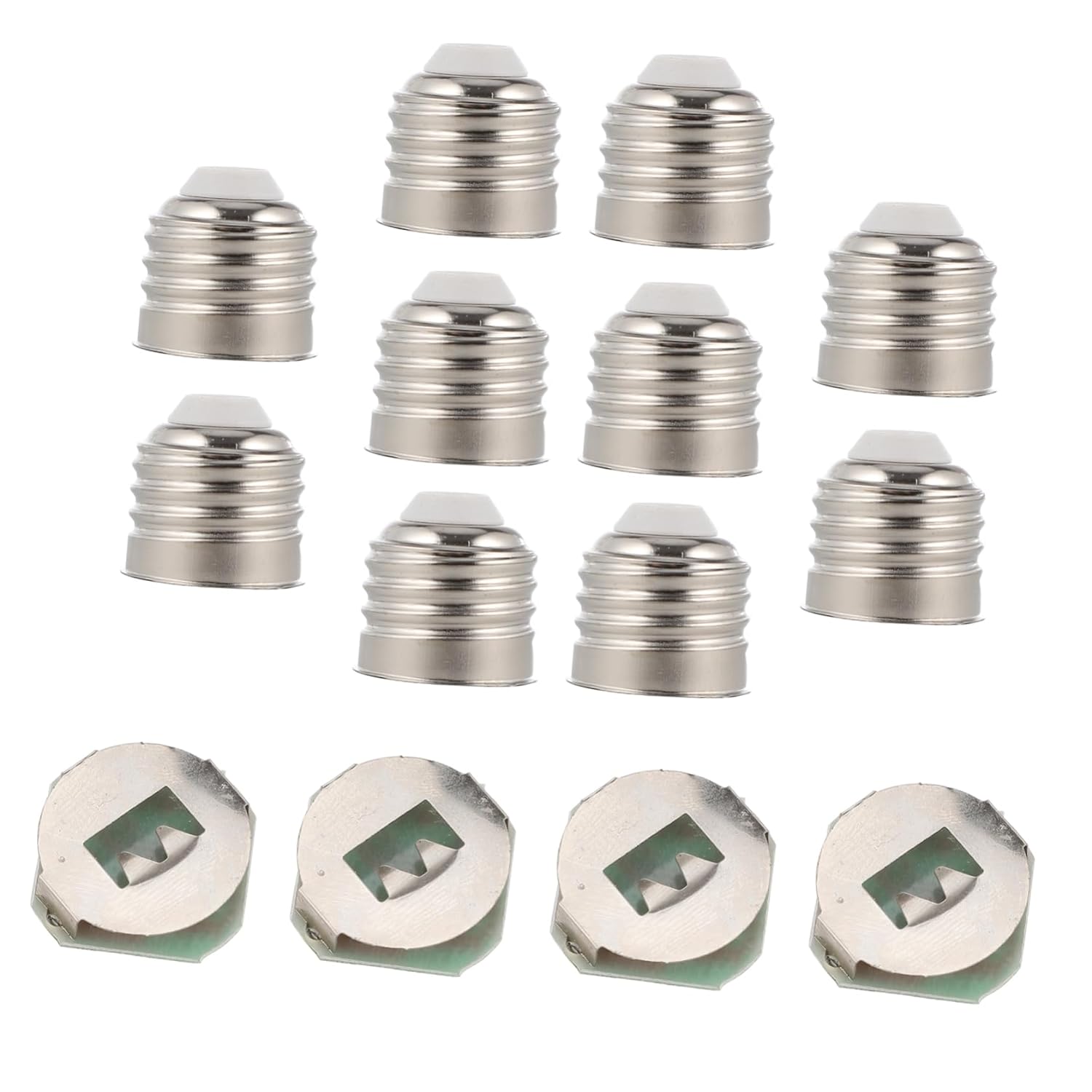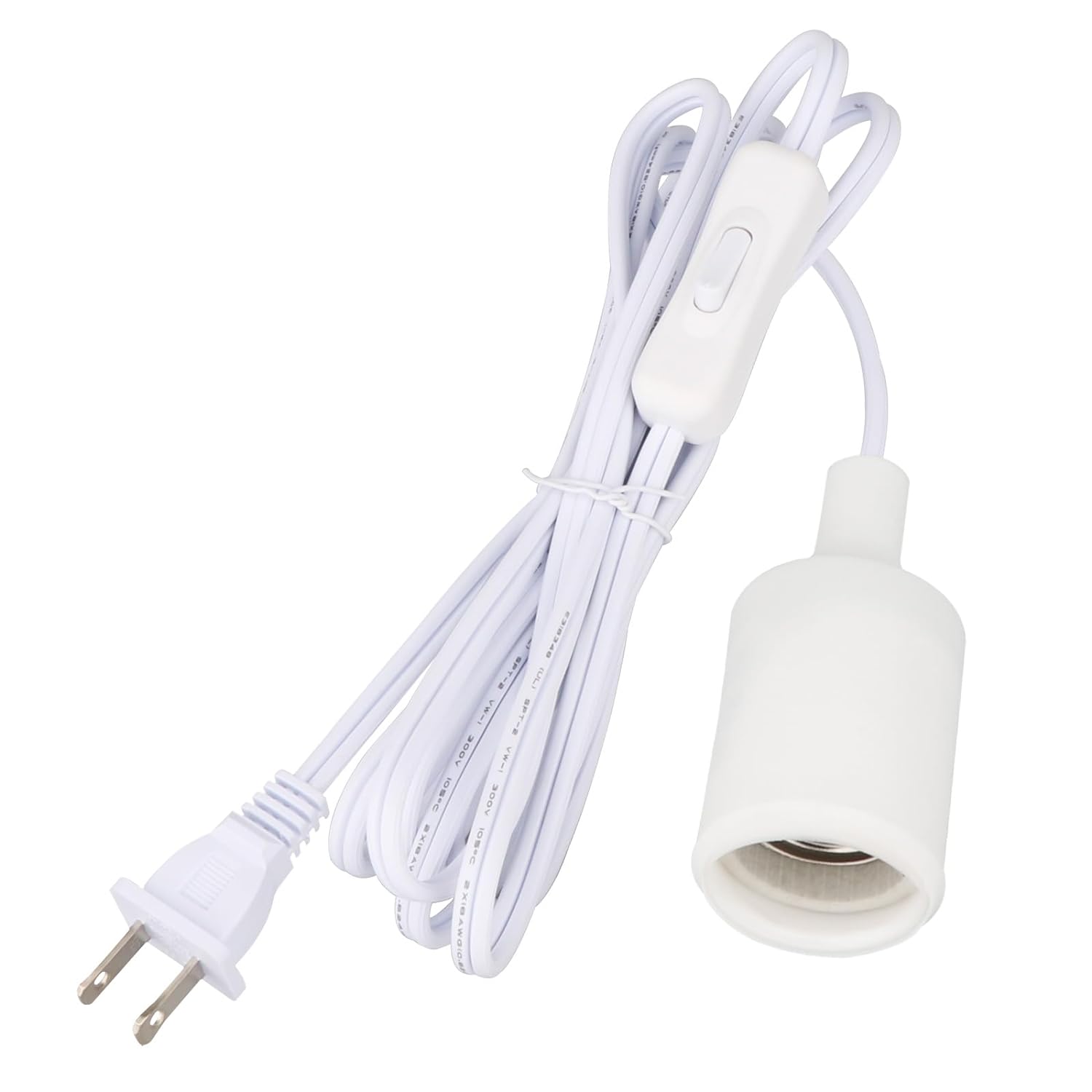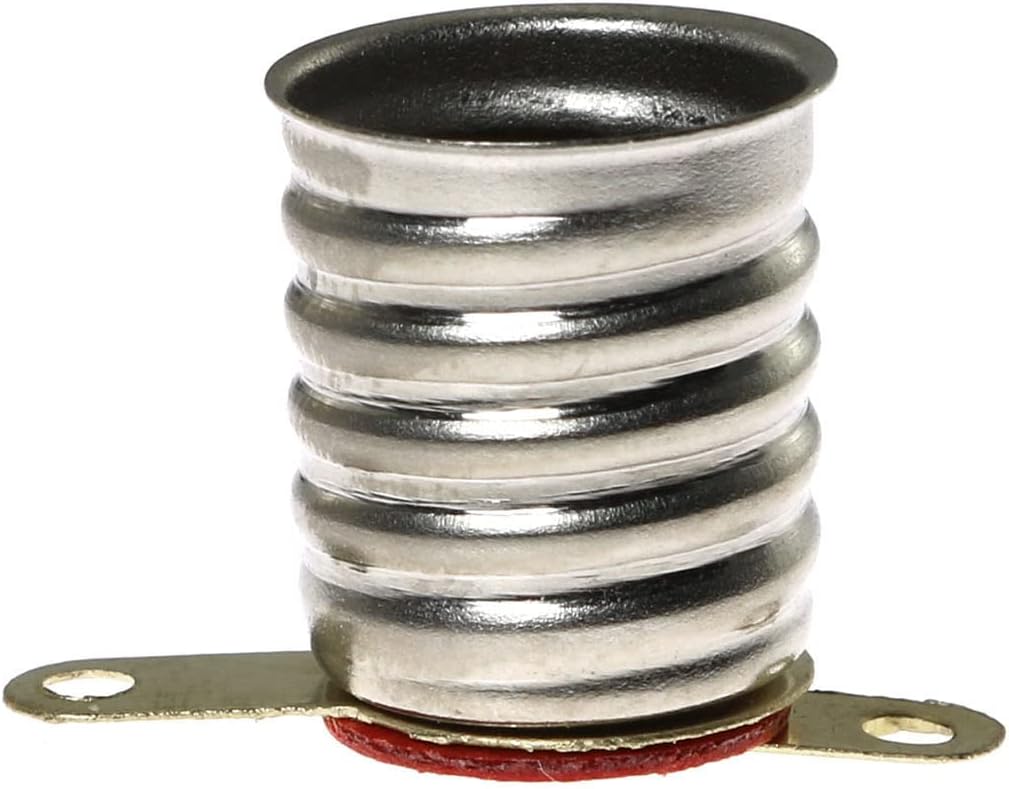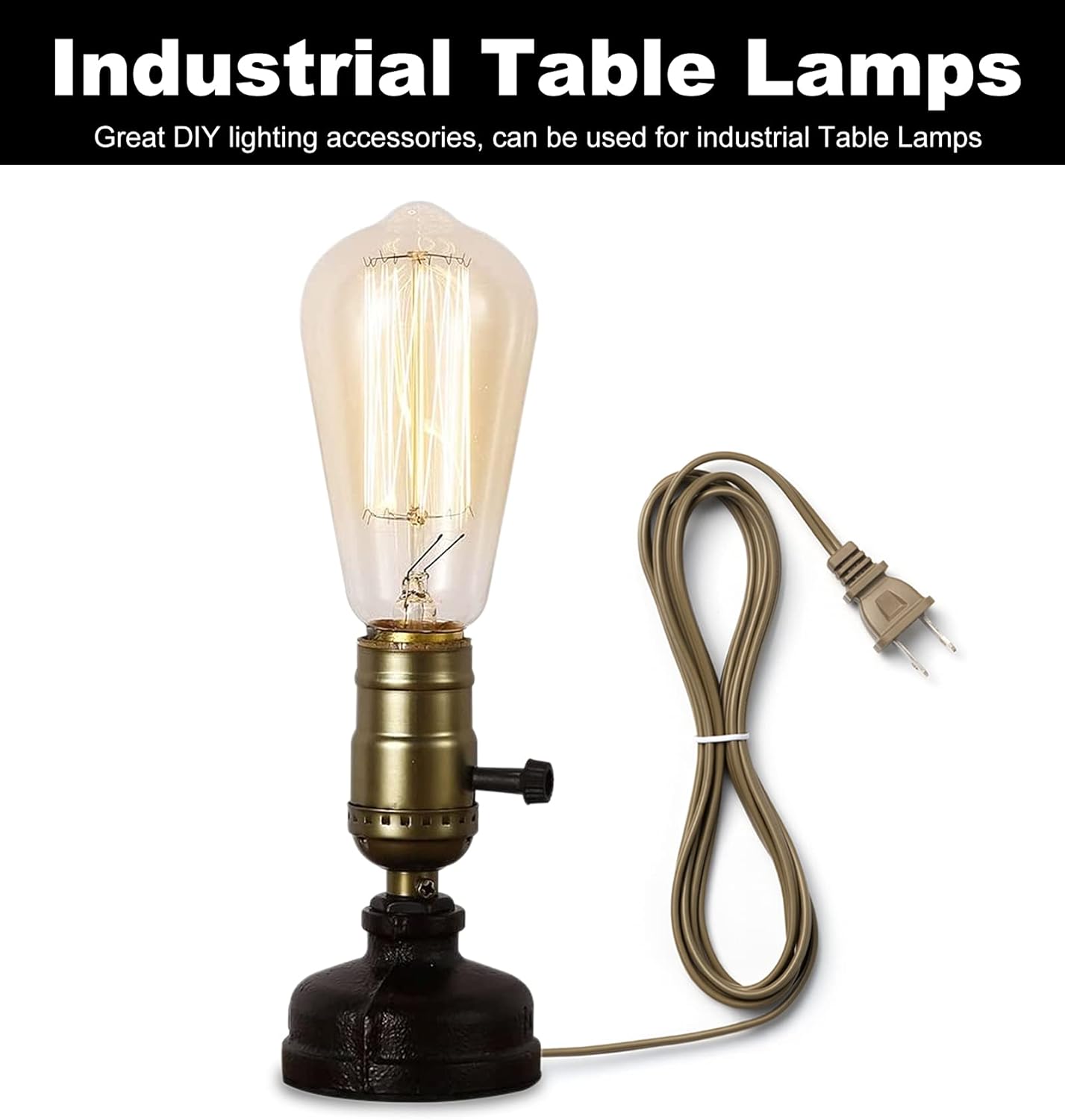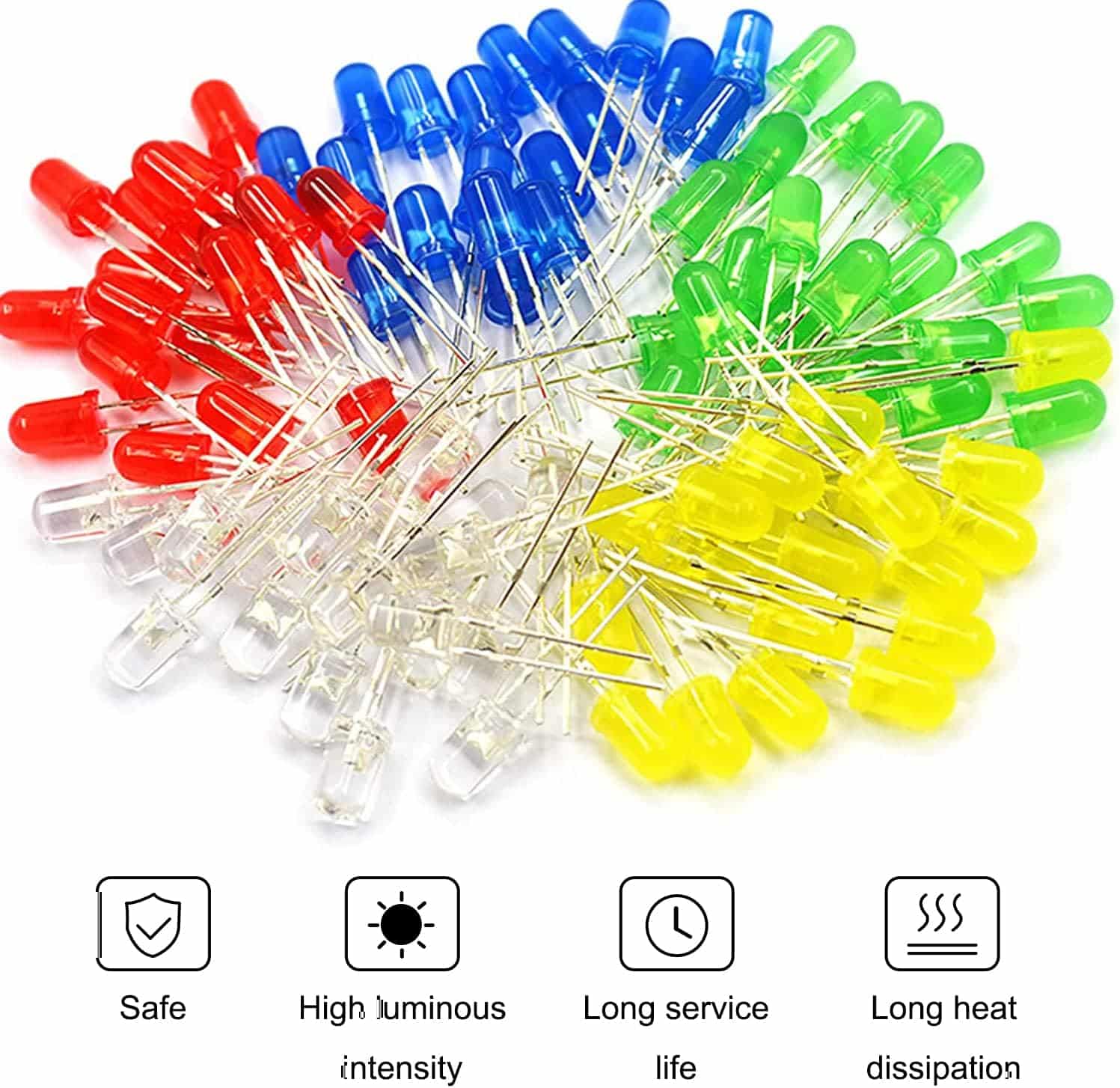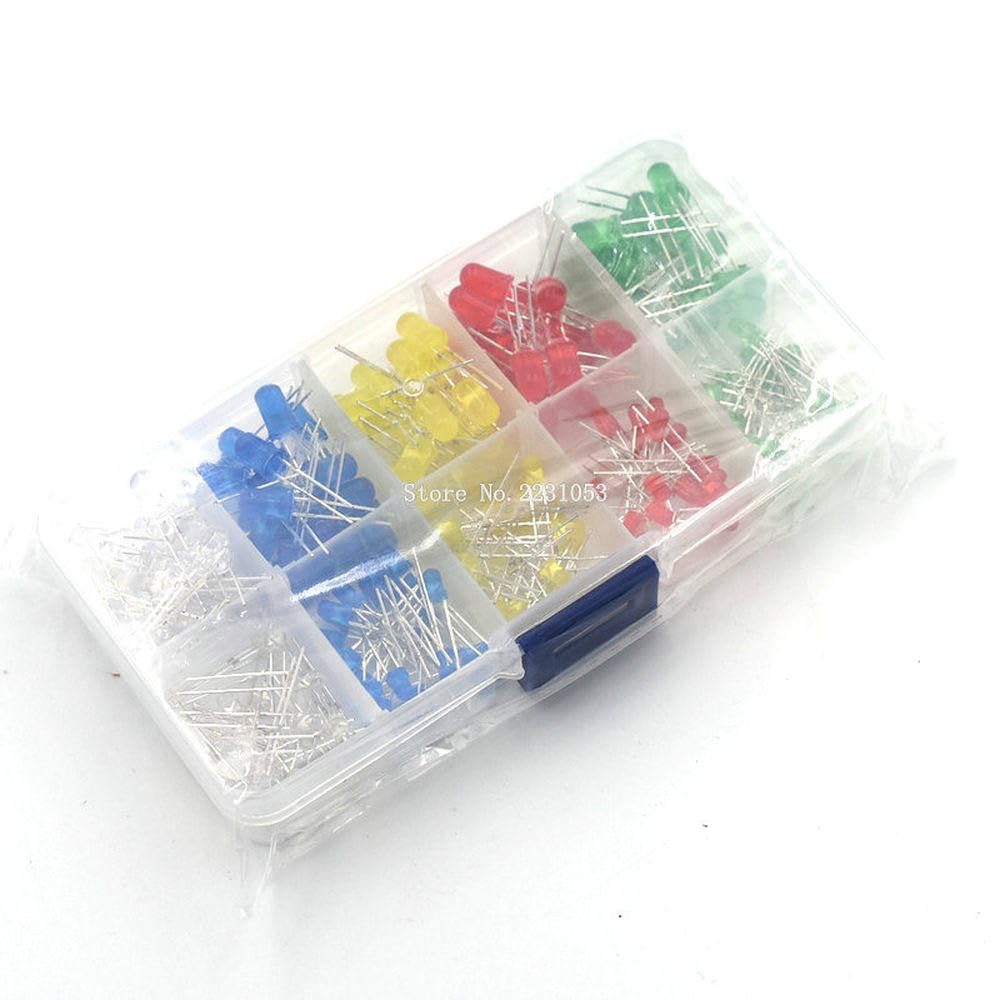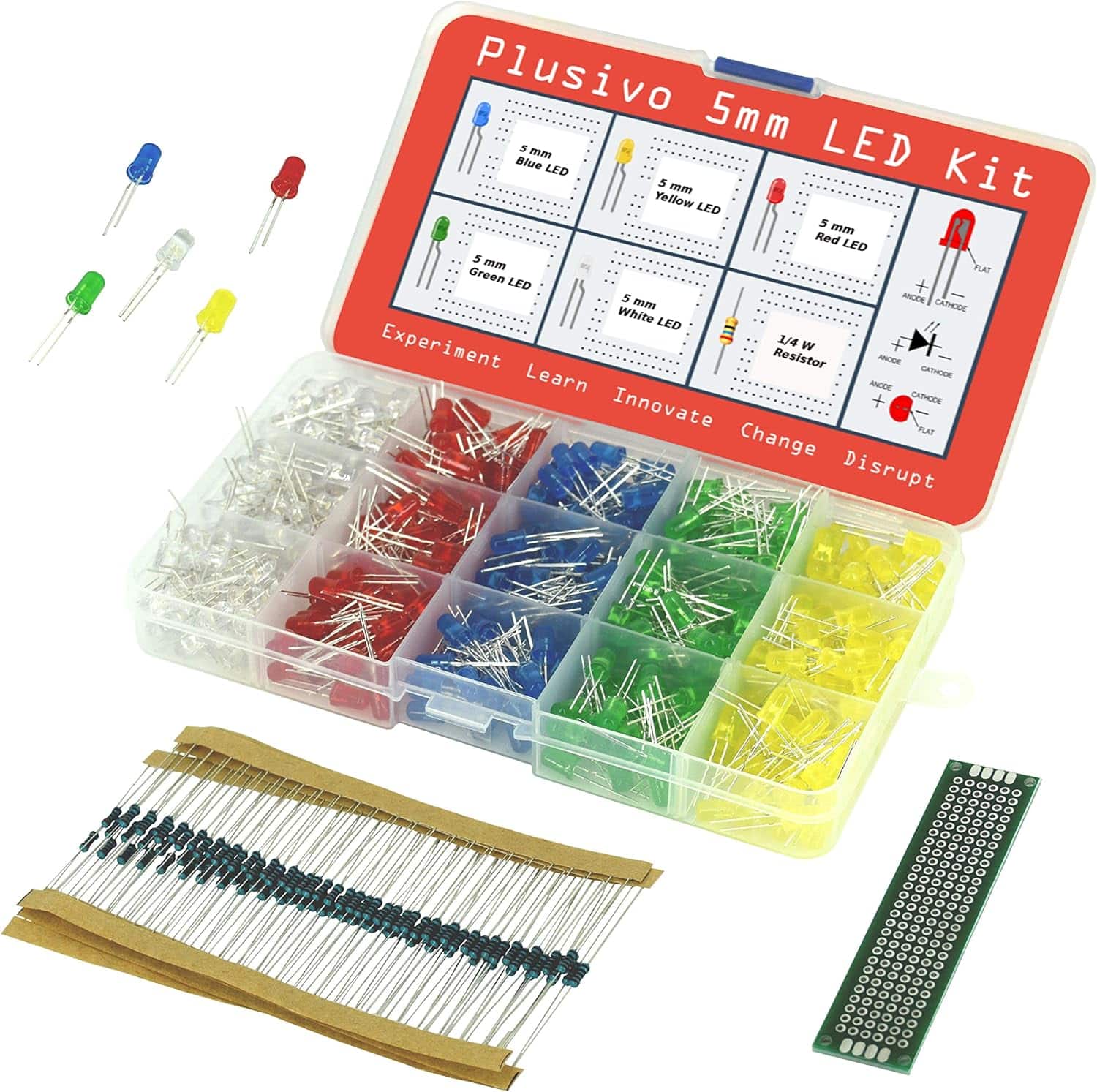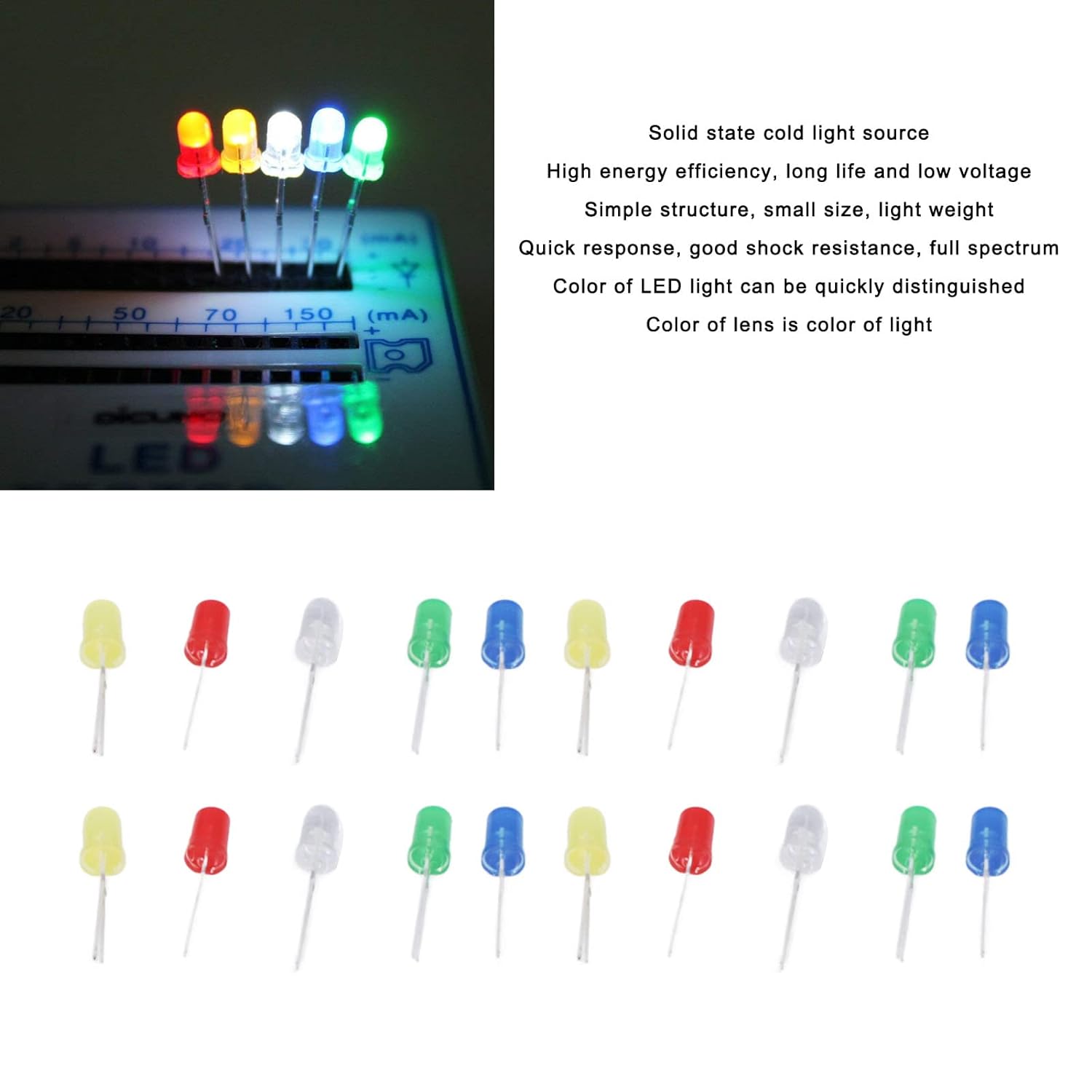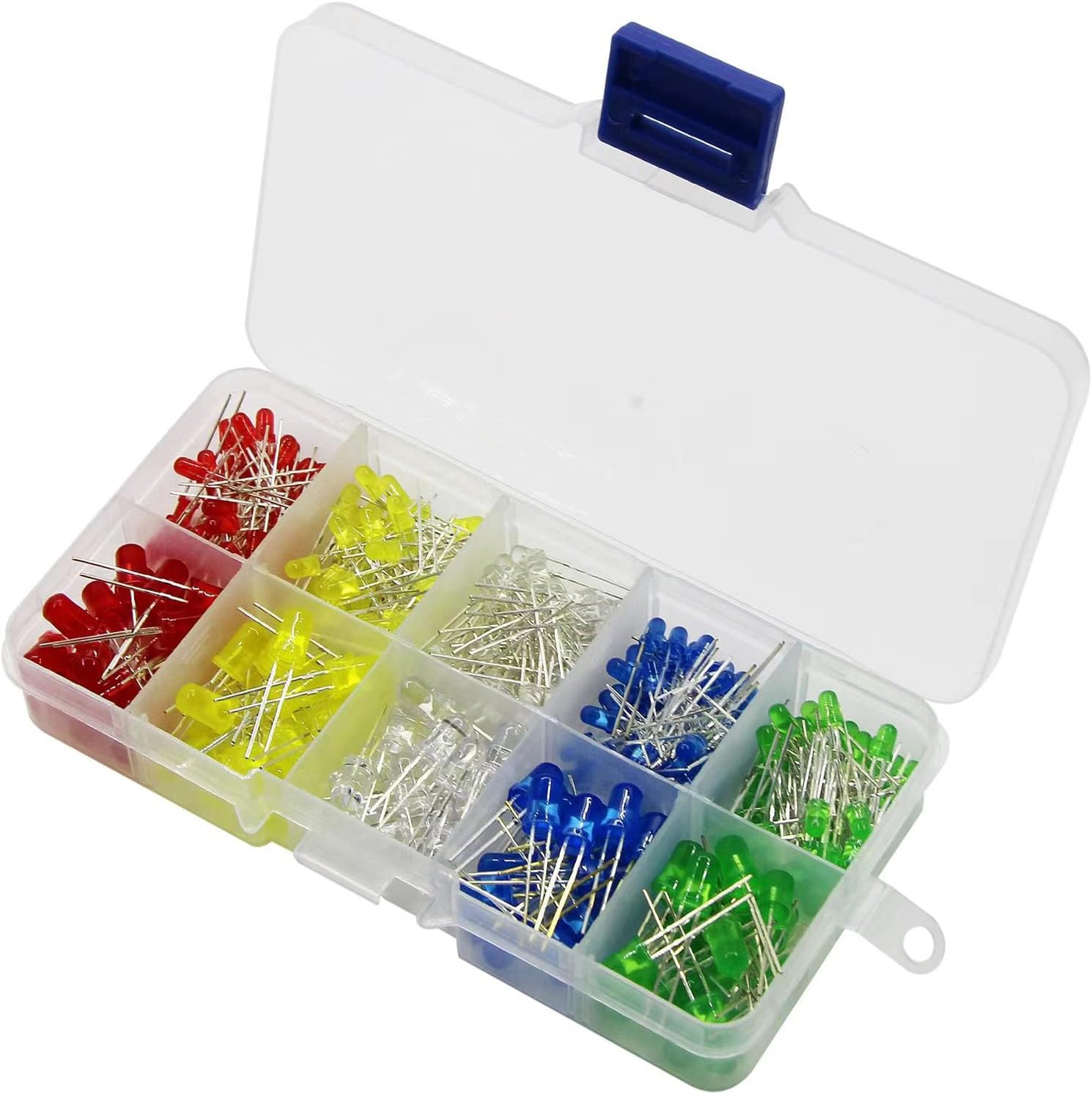As an avid home designer and technology enthusiast, I’m always on the lookout for the latest LED lighting tricks and energy-efficient lighting that can transform my living space. And with the rise of smart home hacks and home automation, it’s never been easier to incorporate creative lighting ideas to revolutionize home lighting design.
Curious about light bulb security and its implication on Internet of Things (IoT) devices? Me too! A while back, I discovered how simple it is to use a $20 light bulb and an $8 RGB LED strip controller for phone control of lights, thanks to a little gadget called an ESP8266-based controller. This controller lets me turn the lights on and off, change colors, and adjust brightness, all from my smartphone! Can we just take a moment to appreciate the convenience?
That’s not all when it comes to home lighting makeover! There are numerous DIY lighting projects and smart LED solutions just waiting for you to explore! Let’s get started and unlock the full potential of energy-efficient lighting for your home.
Key Takeaways
- LED lighting can transform your space for optimal home lighting design.
- Learn creative and energy-efficient lighting tricks for a smart home makeover.
- Understand light bulb security and its impact on IoT devices.
- Discover DIY lighting projects and smart LED solutions to upgrade your space.
- Gain insights on wireless lighting control and home automation integration.
Transform Your Space with Creative LED Placement
Lighting plays a crucial role in setting the atmosphere of our homes, and with the right LED lighting techniques, you can create a welcoming, cozy and bright ambiance. In this section, let’s explore some ingenious LED placement hacks and creative home lighting design tips that will make all the difference.
First off, it’s essential to consider the different types of LED lighting setups that you can use to enhance your space. Here are some popular options:
- Recessed Lighting: These lights are installed directly inside the ceiling, providing a clean and sleek look while offering an ambient LED setup.
- Wall-Mounted Lights: Placing LED lights alongside walls or in specific areas can accentuate architectural features and create decorative lighting effects.
- Under-Cabinet Lighting: This technique utilizes LED strips or small LED lights to add extra brightness and ambiance to kitchen countertops or shelves.
- LED Spotlights: Ideal for highlighting artwork, sculptures or focal points within your home, these lights can be placed on tracks or mounted to the ceiling or walls.
The key to efficient light placement is understanding how light interacts with your space and manipulating it to create desirable effects. Here are some lighting design tips to help you get started:
- Illuminate with Purpose: Use lighting to showcase and elevate specific areas of your home. Consider the room’s purpose and focal points, then add accent lights accordingly.
- Create Layers: Combine various light sources, like ambient, task and accent lighting, to achieve an optimal balance of brightness and warmth.
- Control Shadows: Well-placed lights can help minimize shadows and reduce glare, significantly improving the overall lighting experience.
Pro tip
: Integrating a microcontroller into the existing LED circuitry adds functionality such as motion sensing, which automatically turns LEDs on/off based on movement.
Now for some LED lighting inspiration!
“Creativity is intelligence having fun.” – Albert Einstein
Experiment with unique LED placements and setups to breathe new life into your home and showcase your personal style:
- Create a “Starry Night” effect by placing tiny LED lights on the ceiling of your bedroom or living area.
- Enhance your outdoor living space with LED string lights woven through tree branches, along fences or around patio umbrellas.
- Illuminate staircases or hallways with LED strips, providing safety and a touch of elegance.
In conclusion, when it comes to creative home lighting, the possibilities are endless. With these LED placement hacks and lighting design tips, you can effortlessly transform your space, adding warmth, charm, and a dash of creativity.
Setting the Mood with Color Temperature Variations
Color temperature variations between warm and cool lighting can have a significant impact on the mood and atmosphere of a room. In this section, we’ll explore how different LED color temperatures can influence the ambience of your home and share some tips for choosing the right colors and setting up timed LED scenes.

Understanding the Impact of Warm and Cool Lighting
Warm lighting, with color temperatures around 2,700K, creates a cozy and relaxing environment that is perfect for unwinding after a long day. Cooler lighting, on the other hand, has a color temperature around 5,000K and is ideal for fostering focus and productivity. To enhance the optimal mood in each area of your home, it’s essential to consider the impact of these ambient home lighting temperatures and choose the appropriate LED colors.
“The difference between warm and cool lighting is essential in creating a balanced atmosphere in your home.”
How to Choose the Right LED Colors for Each Room
A room-specific lighting approach is crucial for tailoring your home’s ambience to suit the activities that take place in each space. Here are some recommendations for LED color selection:
- Living Room: Warm tones for a welcoming and cozy atmosphere
- Bedroom: A mix of warm and cool tones, depending on the desired mood for relaxation or productivity
- Home Office: Cool lighting to promote focus and productivity
- Kitchen: Cool lighting for task-oriented activities and energy
- Bathroom: A mix of warm and cool tones to create a relaxing spa-like experience or invigorating morning routine
Transitioning Your Home Ambiance with Timed LED Scenes
Create dynamic home lighting by programming timed LED scenes that change the atmosphere throughout the day. By controlling the color temperature and brightness levels at specific times of day, you can guide the emotional flow of your home:
| Time | Color Temperature | Activity |
|---|---|---|
| Morning | Cool | Starting the day with focused energy |
| Midday | Cool | Maintaining productivity and alertness |
| Evening | Warm | Transitioning to a relaxed state |
| Night | Warm | Winding down for a calm and restful sleep |
Set up your smart LED programming to make these transitions seamless, and enjoy a personalized home lighting experience that enhances your daily routines with the perfect ambiance.
Maximizing Efficiency with Smart LED Solutions
As the world continues to prioritize energy efficiency and sustainable practices, maximizing lighting efficiency is undeniably crucial. I’ve discovered that smart LED solutions can significantly contribute to reducing energy consumption while providing top-quality lighting. In this section, I shall guide you through the world of intelligent LED technology and help you make the most of cost-saving lighting setups.
Efficiency in LED usage comes both from selecting proper wattage for the intended function and from integrating smart solutions that can control power to the LEDs based on conditions like motion detection, thus reducing energy consumption.
Connected LED systems have become increasingly popular and for good reason. Not only do they provide energy-efficient lighting, but they also offer a myriad of features that make controlling and automating lights a breeze. Below are some examples of how to integrate smart LED solutions into your home to make your lighting setup as efficient as possible.
- Motion-detection lighting: Opt for motion-detector-equipped LED lights to minimize energy waste. These intelligent systems turn on only when movement is detected, providing just enough light for the task at hand. This is particularly useful for areas like hallways, storage rooms, and outdoor spaces that only require minimum lighting.
- LEDs with timers: Schedule your lights to turn on and off at specific times, ensuring that they run only when necessary. This can help reduce energy consumption and maintain a routine that suits your lifestyle.
- Adaptive lighting: Incorporate smart lighting systems that automatically adjust their output based on ambient light. By doing so, your lights will provide the right amount of illumination without overusing energy.
- Smartphone-controlled lighting: Manage your lighting setup with a few taps on your mobile device, allowing for easy adjustments and customization. This makes monitoring and controlling your energy use more convenient and efficient.
When choosing LED lights, it is essential to consider the wattage required for the intended function in a room. The table below offers an easy-to-follow guide to determining the right wattage for various areas of the home:
| Room | Intended Function | Suggested Wattage |
|---|---|---|
| Kitchen | Task Lighting | 35-50 watts |
| Living Room | General Lighting | 20-30 watts |
| Bedroom | Relaxation/Reading | 15-25 watts |
| Bathroom | Task Lighting | 25-40 watts |
| Office | Productive Activities | 30-50 watts |
By wisely choosing and implementing these smart LED solutions, you can significantly cut down on energy expenses while maintaining a well-lit and comfortable living space. Remember, saving energy and being gentle on the environment doesn’t have to mean compromising on illumination quality or convenience.
Wireless LED Lighting Controls for a High-Tech Home

As a tech enthusiast, I believe that smart home integration is more than just a trend; it’s the future of comfortable and connected living. One essential aspect that’s been transforming our living spaces is wireless LED lighting. With the rapidly evolving world of home automation systems, controlling the lights in our homes has never been more convenient. In this section, we’ll delve into integrating LED lights with home automation systems and ditching the switch for voice-activated and app-controlled lights.
Integrating LED Lights with Home Automation Systems
LED light automation through home automation systems is not just about being tech-savvy; it’s also about seamless smart home integration. By connecting your LED lights to intelligent lighting networks, you can reap several benefits, such as remote control, scene changes, and even compatibility with other smart home devices. This cohesive system elevates the overall home lighting experience and merges convenience with energy-efficiency.
Tip: To get the most out of your home automation system, choose LED lights that are specifically designed for smart home integration.
Ditching the Switch: Voice-Activated and App-Controlled Lights
Imagine walking into a room and commanding your lights to turn on without having to lift a finger. The age of switch-free LED control is upon us! With voice-activated lights, managing your home’s illumination has never been easier. From adjusting brightness levels to changing colors, you can now have complete hands-free lighting control.
Beyond voice activation, app-controlled lighting is also revolutionizing the way we interact with our spaces. With the help of a user-friendly application, you can manage your mobile lighting anywhere and anytime, straight from your smartphone. This advanced LED control system is perfect for busy professionals on-the-go or for added convenience in your everyday life.
Here’s a quick comparison of Voice-Activated and App-Controlled LED Lights:
| Feature | Voice-Activated Lights | App-Controlled Lights |
|---|---|---|
| Hands-free use | Yes | No |
| Command Range | Smart Speaker’s Range | Unlimited (via Internet) |
| Customization | Limited to voice commands | Flexible controls using the app |
| Compatibility with other devices | Requires compatible smart speaker | Requires smart device with the app |
In conclusion, integrating wireless LED lighting controls in a high-tech home is both convenient and energy-efficient. Embrace the future of connected living by exploring smart home integration and making the switch to voice-activated and app-controlled lights!
The Art of Layering Lights for Depth and Dimension
Discovering the layering lights technique involves an understanding of the subtle yet powerful ways in which lighting can be manipulated to create depth and dimensionality in any space. By mastering the artful LED layering, you can achieve a more dynamic and visually captivating environment, redefining the interior lighting depth of your home.
It is essential to have a strategic lighting placement plan to create the desired effect. Here, we’ll break down the basics of this technique and provide some practical tips for artfully layering LED lights in your home.
- Ambient lighting – This serves as the primary light source and provides a general illumination. Ceiling lights, chandeliers, or LED strip lights can establish the base layer of lighting in your dimensional home lighting design.
- Task lighting – This layer is specifically aimed at illuminating areas where specific tasks will be performed, such as a desk, a kitchen counter, or a reading nook. Directional LED lights or under-cabinet LED strips can be used for this purpose.
- Accent lighting – This final layer is used to highlight architectural features, artwork, or decor elements in a room. LED spotlights, wall sconces, or even LED backlights behind a painting can turn a regular space into a visually compelling masterpiece.
Remember: The key to successful layering is to balance the three layers effectively, ensuring that no single layer dominates and all contribute to creating depth and dimension.
Practical Tips for Artful LED Layering
- Adjust color temperatures: Blend warm and cool LED lights to create a harmonious visual palate that adds depth to your space.
- Explore brightness variations: Varying the brightness levels of your LED lights can make your space feel more expansive and engaging. Dimmable LEDs are excellent tools for this task.
- Experiment with light direction: Directing the light towards or away from specific focal points in a room can create exciting visual contrasts and enhance the layered effect.
- Consider light sources: Combine different types of LED light fixtures and styles to create a unique layering effect that speaks to your personal design aesthetic.
In conclusion, mastering the layering lights technique allows you to create lighting depth and enhance the overall ambiance of your living spaces. By strategically placing LEDs at different levels, and combining various light sources, you can transform your home’s interior into a dynamic and visually captivating environment that truly reflects your unique style.
Reinventing Spaces with LED Strip Lights
LED strip lights are becoming increasingly popular for their versatility and potential. From accentuating architectural features to adding subtle atmosphere, these lighting innovations can truly reinvent spaces and create impactful lighting accents. To harness the full potential of LED strip lights, let’s explore some unique LED uses and installation tips for a seamless and hidden LED glow.
Unique Ways to Use Strips for Impactful Accents
- Shelf and cabinet backlighting: Add a soft glow to your bookshelves or kitchen cabinets by installing LED strip lights along the edges. This creates a visually appealing warmth that enhances the overall atmosphere of your space.
- Staircase illumination: Guide your feet and add a touch of elegance to your stairs by incorporating strip lights along the steps or underneath the handrails.
- Mood lighting for bedrooms: Create a cozy haven by installing LED strips behind your headboard or at the base of your bed frame. This creates a soft, ambient light perfect for winding down after a long day.
- Outdoor applications: Enhance the appearance of your garden or patio by using LED strip lights along pathways, planters, or pergolas.

Installation Tips for a Seamless and Hidden LED Glow
To ensure your LED strip light installation achieves the desired seamless glow, follow these essential tips:
- Placement: Properly position the strips out of direct sight lines, using hidden LED techniques such as mounting them under cabinets, behind shelves, or within recesses of your space. This creates a discreet LED lighting effect, allowing for an invisible LED setup.
- Securing the strips: Ensure they remain firmly in place by utilizing appropriate brackets, clips, or adhesive strips designed for LED strip light installation.
- Avoiding gaps: To create a continuous, seamless LED glow, check that there are no gaps or overlaps that could compromise the overall lighting effect.
- Power source: Consider the power requirements of your LED strip lights and ensure a suitable and accessible power supply is available. This may involve using an extension cord, transformer, or connecting to a nearby power outlet.
- Wiring: Tidy up any exposed cables or wires to maintain a clean, professional appearance.
With a bit of creativity and attention to detail, LED strip lights can revolutionize the way you illuminate your spaces. Experiment with different applications and follow these installation guidelines to achieve the perfect seamless glow and a refined aesthetic.
Finding the Perfect LED Fixtures for Your Décor
When it comes to enhancing your space with the perfect LED lighting fixtures, interior design and décor matching are essential considerations. You may be wondering how to select the most stylish LED solutions that both complement your home’s aesthetics and provide the desired lighting effects. I’m here to share my insights on achieving that perfect balance with the ideal LED selection.
“Design is not just what it looks like and feels like. Design is how it works.” – Steve Jobs
In order to find the perfect LED fixtures, you need to consider the following factors:
- Fixture design: Choose a design that aligns with the room’s style, balancing form and function.
- Light output: Select fixtures that provide the appropriate amount of illumination for the room’s purpose.
- Color temperature: Consider the ambience and mood you want to create, opting for either warm or cool LED lights accordingly.
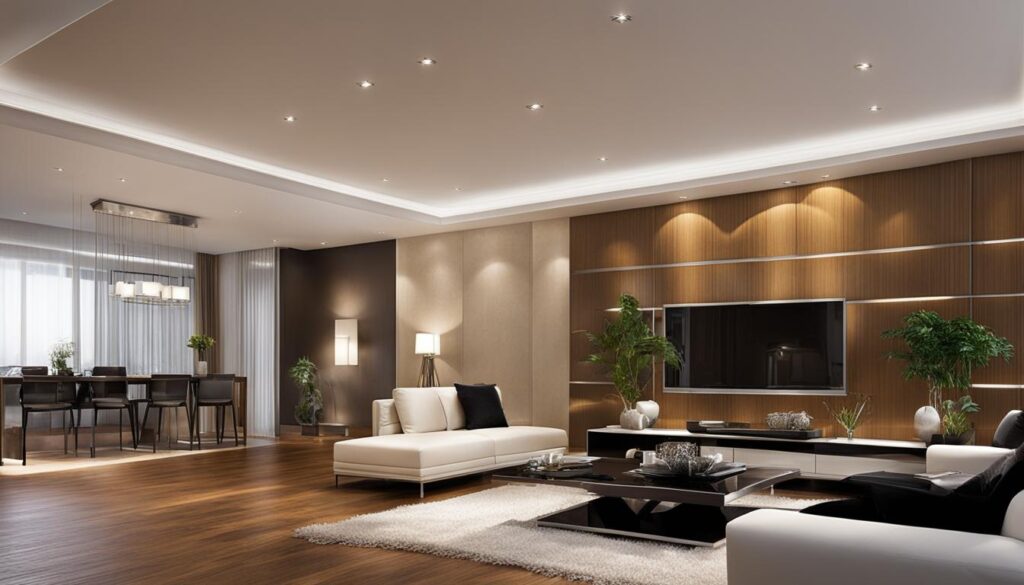
Here is a table illustrating examples of LED fixtures that can elevate the aesthetic and lighting impact in different room styles:
| Room Style | LED Fixture Example | Color Temperature |
|---|---|---|
| Modern Minimalist | Recessed LED downlights | Cool White (4000K) |
| Rustic | Wooden pendant with Edison-style LED bulbs | Warm White (2700K) |
| Industrial | Exposed track LED lighting | Neutral White (3000K) |
| Glamorous | Crystal chandelier with integrated LEDs | Cool White (4000K) |
| Cozy Bohemian | LED string lights | Warm White (2700K) |
Remember, decor-enhancing LEDs are more than just a design statement, they have the power to transform a space both visually and functionally. By considering fixture design, light output, and color temperature, you can maximize the impact of your interior design lighting and create a harmonious, inviting atmosphere in your home.
Unlocking the Potential of Dimmable LED Features
Dimmable LED lights not only save you energy but also open up endless possibilities for home lighting control, adaptable ambiance, and creativity. In this section, we will explore the world of dimmable LED features, starting with understanding dimmer compatibility and setup, and moving on to creating dynamic LED lighting effects using dimmable technology.
Understanding Dimmer Compatibility and Setup
To achieve a seamless light dimming setup, ensure your dimmable LED features are compatible with the LED dimmer switch that you’re using. Compatibility is crucial because not all LED lights or dimmers are created equal. Selecting the right dimmer switch for your LEDs is essential to enable adjustable LED brightness with no flickering or inconsistencies.
Pro tip: Keep an eye out for dimmable light technology with customizable lighting levels and verified LED dimmer compatibility, as stated by the manufacturer.
Once you’ve found compatible dimmers and LEDs, it’s time to set up your dynamic LED lighting system. Firstly, check your wiring and connections. Match up the load wires from your LED lights to the dimmer switch wires, connect the ground wire, and secure everything with wire nuts. Test your connections before installing the switch on the wall and adjusting the dimmer to your preference.

Creating Dynamic Lighting Effects with Dimming
Now that the compatibility and setup are covered, let’s dive into the exciting aspect of dimmable LED capabilities – the creative light dimming possibilities. Dimming your LEDs can enhance the atmosphere of any setting, adding a touch of dynamic illuminance and mood lighting to your home.
Create instantaneous ambiance and customized environments using the following techniques:
- Play with upper and lower limits to find your perfect LED dimming effects and settings. Adjust the maximum brightness for daytime use, and set a dimmer minimum for cozy evenings and dark conditions.
- Combine colored LEDs with dimming functions to create vibrant and adjustable mood lighting for entertaining guests, movie nights, or romantic dinners.
- Integrate smart home controls for seamless transition between LED dimming presets tailored for different activities, such as morning routines, work hours, and relaxation time.
In a nutshell, dimmable LED features are a game-changer that can elevate your home’s lighting design and atmosphere. By understanding compatibility, getting the setup right, and experimenting with LED dimming effects, you can significantly enhance your home’s ambiance and create customizable lighting levels for different moods and occasions. Don’t be afraid to get creative and let your imagination run wild!
Embracing the Future of LED Lighting in Home Design
With the continuous advancements in the lighting industry, it’s essential to stay ahead and integrate innovative ideas into our homes. Through the use of LED lighting best practices, we can create a transformative and efficient atmosphere while always remaining stylish and current. These transformative LED tips can foster an inviting ambience and seamlessly elevate the overall design of any space.
As the future of home lighting gravitates toward smart and customizable solutions, aligning ourselves with these new technologies can prove to be advantageous. By adopting energy-saving lighting strategies and closely monitoring the emerging LED lighting trends, it allows us to stay in tune with the latest gadgets and control systems that are shaping the new era of home illumination.
Ultimately, the key is to incorporate these innovative lighting techniques and smart LED solutions to create a harmonious and dynamic environment within our homes. By fusing technology, design, and sustainability, we are not only nurturing a beautiful and energy-efficient residence but also embracing the diverse and progressive future of home lighting design.
FAQ
What are some creative LED placement ideas for my home?
Creative LED placement ideas include layering lights for depth and dimension, highlighting architectural features, using LED strip lights for under-cabinet or shelf accents, and incorporating LED lights into artwork or furniture pieces.
How can I change the mood of my home using color temperature variations?
Warm lighting creates a cozy, relaxed atmosphere, while cool lighting is more energizing and enhances productivity. Use cooler tones in task-oriented rooms and warmer tones in spaces meant for relaxation. Timed LED scenes can add another layer to the ambiance by transitioning between colors or brightness levels in various rooms throughout the day.
Are there energy-efficient LED solutions available?
Yes, look for smart LED solutions like energy-saving bulbs, motion sensor-controlled lighting, and integration with home automation systems. These technologies can help optimize energy use by adjusting brightness, automatically turning lights off, and setting schedules based on activity.
What is the benefit of integrating LEDs with home automation systems?
Integrating LEDs with home automation systems allows for remote control, scene changes, and seamless integration with other smart home devices. Voice activation and app control can also provide added convenience and hands-free operation, making life easier and more efficient.
What are some unique ways to use LED strip lights?
LED strip lights can be used as accent lighting for bookcases, shelves, and architectural features. They’re also great for backlighting televisions, headboards, and ceiling coves. The key is to install them where they’re hidden from direct sight, creating a soft, seamless glow.
How do I choose the right LED fixture for my décor?
When choosing an LED fixture, consider the style and function of the room, as well as the desired lighting effect. Pay attention to fixture design, light output, and color temperature to ensure your selection complements the space’s décor and meets your lighting needs.
What should I know about dimmable LED features?
Understanding dimmer compatibility and setup is crucial to setting up dimmable LEDs. Choose the right dimmer switch that matches the LED’s specifications to enable adjustable brightness levels. With the right setup, you can create dynamic lighting effects and moods by controlling the intensity of your LED lights.


